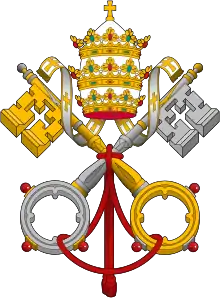Association of the Christian faithful
In the Catholic Church, an association of the Christian faithful or simply association of the faithful (Latin: consociationes christifidelium[1]) is a group of baptized persons, clerics or laity or both together, who, according to the 1983 Code of Canon Law, jointly foster a more perfect life or promote public worship or Christian teaching, or who devote themselves to other works of the apostolate.[2]
 |
| Part of a series on the |
| Canon law of the Catholic Church |
|---|
|
|
A 20th-century resurgence of interest in lay societies culminated in the Second Vatican Council, but lay ecclesial societies have long existed in forms such as sodalities (defined in the 1917 Code of Canon Law as associations of the faithful constituted as an organic body),[3] confraternities (similarly defined as sodalities established for the promotion of public worship),[4] medieval communes, and guilds.
Terminology
Under the 1917 Code of Canon Law, groups of laity that gathered with a common purpose and apostolate were called piae uniones ("pious unions" or "pious associations").[5] With the replacement of the former code by the 1983 Code of Canon Law, they were referred to as associations of the faithful.[2]
Pope John Paul II's apostolic exhortation Christifideles laici of 30 December 1988 spoke of "the flourishing of groups, associations and spiritual movements as well as a lay commitment in the life of the Church" in the years following the Second Vatican Council, "resulting in the birth and spread of a multiplicity of group forms: associations, groups, communities, movements".[6]
A Pastoral Note of the Italian Episcopal Conference issued on 29 April 1993 defined three of the terms:
- Associations. Those whose structure is organic and institutional with regard to composition of governing bodies and membership.
- Movements. Those united not so much by institutional structure as by adherence in way of life to certain dynamic ideas and by a shared spirit.
- Groups. Those with a certain spontaneity in the way of joining them, wide freedom in self-structuring, and somewhat limited size, giving rise to more homogeneous membership.
However, it added that these terms are often applied quite loosely.[7] For example, the Community of Sant'Egidio, which calls itself a community, is also described as a movement.[8]
Associations of the faithful are distinguished from institutes of consecrated life and societies of apostolic life.[2] A group of people who intend to become an institute of consecrated life or society of apostolic life will normally come together at first as an association of the faithful, while awaiting the decision of the bishop, after consulting the Holy See, to establish them in the desired form.[9]
Ecclesiastical approval
Associations that are approved on an international level are approved by the Dicastery for the Laity, Family and Life (previously by the Pontifical Council for the Laity) and listed in the Directory of International Associations of the Faithful. Associations that exist on a national level are approved by a country's episcopal conference, while those at a diocesan level are approved by the local bishop.
Examples
Franciscan Brothers of Peace
The Franciscan Brothers of Peace, a canonically recognized Public Association of the Faithful was founded in St. Paul, Minnesota, in 1982. In keeping with their pro-life charism, the Brothers advocate for the unborn, the handicapped, the elderly and the poor. They operate a food pantry and working with the Center For Victims of Torture provide temporary shelter for international victims of torture who have arrived in the Twin Cities area..[10]
Amigonian Cooperators
The Amigonian Cooperators was instituted by the Capuchin Tertiaries (Amigonian Friars). Their work among the laity following the charism of the Capuchin Bishop Luis Amigó y Ferrer (1854-1934) dates back to 1937. On 8 December 1992, the Pontifical Council for the Laity recognized the Cooperadores Amigonianos as an international association of the faithful of pontifical right.[11]
Franciscan Brothers of the Eucharist
The Franciscan Brothers of the Eucharist, founded in 2002 as a companion community to the Franciscan Sisters of the Eucharist, is a Public Association of the Faithful approved by the Archdiocese of Hartford.[12] As their particular and primary charism is upholding the dignity of the human person, their ministry has included public pro-life prayer vigils, counseling the mentally ill, caring for the elderly and coordinating outdoor adventure programs for youth.[13] Each Brother is assigned to work in a professional field suited to his personal talents and education. They also engage in manual labor, growing vegetable gardens, flower gardens, and raising small farm animals, such as chickens.
Saint Francis Third Order Confraternity of Penitents
The Saint Francis Third Order Confraternity of Penitents is a private association of the faithful recognized pursuant to CIC/83 canon 299 §3 by the Bishop of the Diocese of Fort Wayne - South Bend on March 25, 2019.[14]
See also
References
- 1983 Code of Canon Law, Latin original, canon 298.
- Canon 298 §1
- Canon 707 §1 of the 1917 Code of Canon Law
- Canon 707 §2 of the 1917 Code of Canon Law
- "Associationes fidelium quae ad exercitium alicuius operis pietatis aut caritatis erectae sun, nomine veniunt 'piarum unionum'; quae, si ad modum organici corporis sunt constitutae, 'sodalitia' audiunt" (Associations of the faithful which are established for carrying out some pious or charitable work are called "pious unions"; if they are constituted as an organic body, they are referred to as "sodalities") - canon 707 §1 of the 1917 Code of Canon Law
- Christifideles laici, 1 and 29
- Le aggregazioni laicali nella Chiesa, p. 88 Quote: "Col nome di associazioni si indicano le aggregazioni che hanno una struttura organica ed istituzionalmente caratterizzata quanto alla composizione degli organi direttivi e all'adesione dei membri. I1 nome di movimenti è attribuito a quelle realtà aggregative nelle quali l'elemento unificante non è tanto una struttura istituzionale quanto l'adesione «vitale» ad alcune idee-forza e ad uno spirito comune. Sono denominati gruppi le aggregazioni di vario tipo che sono caratterizzate da una certa spontaneità di adesione, da ampia libertà di auto-configurazione e dalle dimensioni alquanto ridotte, che permettono una maggiore omogeneità tra gli aderenti. In un campo nel quale ben raramente si danno realtà rigide e fisse, non sempre i termini di associazione, movimento e gruppo corrispondono alla figura sostanziale che designano."
- About the Community
- Canons 579 and 732
- "Our History", Franciscan Brothers of Peace
- Pontifical Council for the Laity, "International Associations of the Faithful", Libreria Editrice Vaticana, 2006 Archived September 26, 2011, at the Wayback Machine
- Franciscan Brothers of the eucharist
- Beattie, Trent. "Surprising Revival for Men in Religious Life", National Catholic Register, November 25, 2011
- Saint Francis Third Order Confraternity of Penitents
External links
- Pontifical Council for the Laity, "International Associations of the Faithful", Libreria Editrice Vaticana
- Brendan Leahy, Ecclesial Movements and Communities: Origins, Significance, and Issues (New City Press, 2011)
- Book review of Cities of God: The Religion of the Italian Communes 1125-1325 by Augustine Thompson, OP
- David Dieterich, Brotherhood and Community on the Eve of the Reformation: Confraternities and Parish Life in Liege, 1450-1540
